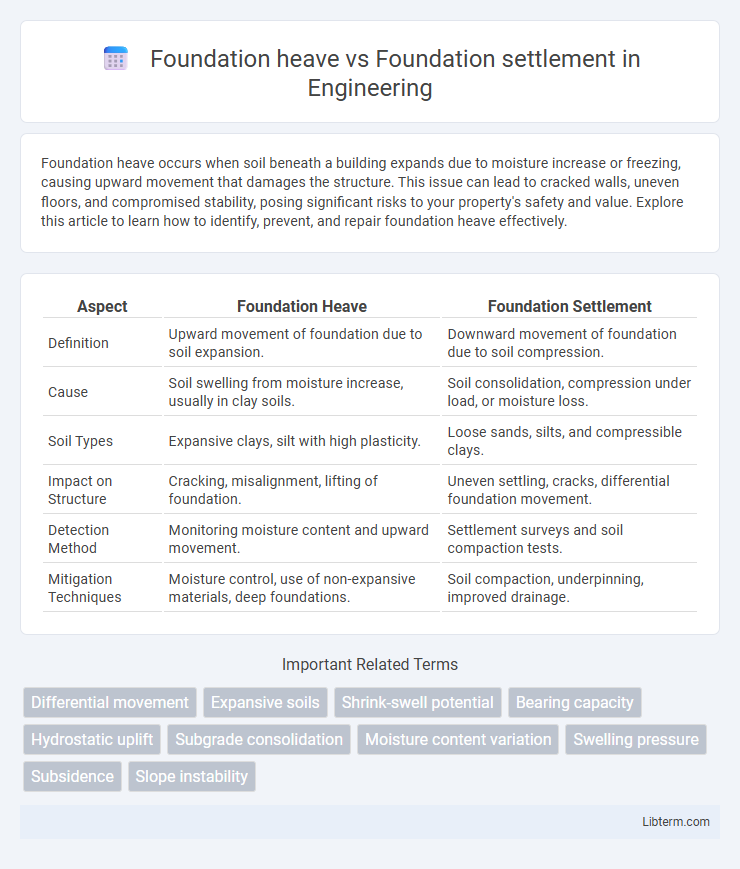Foundation heave occurs when soil beneath a building expands due to moisture increase or freezing, causing upward movement that damages the structure. This issue can lead to cracked walls, uneven floors, and compromised stability, posing significant risks to your property's safety and value. Explore this article to learn how to identify, prevent, and repair foundation heave effectively.
Table of Comparison
| Aspect | Foundation Heave | Foundation Settlement |
|---|---|---|
| Definition | Upward movement of foundation due to soil expansion. | Downward movement of foundation due to soil compression. |
| Cause | Soil swelling from moisture increase, usually in clay soils. | Soil consolidation, compression under load, or moisture loss. |
| Soil Types | Expansive clays, silt with high plasticity. | Loose sands, silts, and compressible clays. |
| Impact on Structure | Cracking, misalignment, lifting of foundation. | Uneven settling, cracks, differential foundation movement. |
| Detection Method | Monitoring moisture content and upward movement. | Settlement surveys and soil compaction tests. |
| Mitigation Techniques | Moisture control, use of non-expansive materials, deep foundations. | Soil compaction, underpinning, improved drainage. |
Understanding Foundation Heave and Settlement
Foundation heave occurs when soil beneath a structure expands, causing the foundation to lift and potentially damage the building. Foundation settlement happens when soil compresses or shifts, leading the foundation to sink unevenly and create structural instability. Understanding these phenomena is crucial for designing appropriate mitigation strategies in geotechnical engineering.
Causes of Foundation Heave
Foundation heave occurs primarily due to soil expansion, often caused by moisture increase in clay-rich soils that swell when wet. This phenomenon can also result from the freezing of water in the soil beneath the foundation, leading to frost heave. In contrast, foundation settlement is typically caused by soil compression under load, highlighting the key difference in underlying mechanisms.
Common Triggers of Foundation Settlement
Foundation settlement often results from soil consolidation, changes in moisture content, and inadequate soil compaction beneath the foundation. These triggers cause the ground to compress unevenly, leading to differential settlement and structural damage. Foundation heave, in contrast, is typically caused by soil expansion due to moisture increase or frost action, pushing the foundation upward rather than sinking.
Signs and Symptoms of Heaving Foundations
Heaving foundations often exhibit visible signs such as upward movement of concrete slabs, cracked walls with vertical or stair-step patterns, and doors or windows that stick or fail to close properly due to shifting support beneath the structure. Uneven floors and gaps between walls and floors may also indicate soil expansion causing foundation heave, typically from clay soils swelling with moisture. Early detection of these symptoms is crucial to prevent severe structural damage and costly repairs compared to foundation settlement, which involves downward soil movement and different distress patterns.
Indicators of Settling Foundations
Indicators of settling foundations include visible cracks in walls, uneven floors, and doors or windows that stick or fail to close properly. Signs such as sloping or tilting floors, gaps between walls and ceiling or floor, and misaligned structural elements also point to foundation settlement. Monitoring these symptoms helps differentiate foundation heave, which typically causes upward movement and cracking near basement floors, from downward settlement issues.
Impact of Soil Types on Foundation Movement
Expansive clay soils cause foundation heave due to their high moisture absorption leading to swelling and upward soil pressure, while sandy or silty soils commonly result in foundation settlement because of their lower cohesion and susceptibility to compaction and erosion. Understanding soil types such as expansive clays, loose sands, and silts is critical for predicting foundation movement and implementing suitable engineering solutions. Soil moisture variation in clay soils intensifies heave risks, whereas poor drainage in granular soils accelerates settlement, impacting structural stability differently.
Engineering Solutions for Foundation Heave
Foundation heave occurs when the soil beneath a structure expands, causing upward movement, while foundation settlement involves the downward sinking of foundations due to soil compaction or load stress. Engineering solutions for foundation heave include installing moisture barriers, using non-expansive soil replacement, and designing adjustable foundations to accommodate soil volume changes. Effective geotechnical investigation and soil stabilization techniques are critical to prevent structural damage linked to foundation heave.
Methods to Address Foundation Settlement
Foundation settlement can be addressed through methods such as underpinning, which involves strengthening and stabilizing the existing foundation by extending it to deeper, more stable soil layers. Grouting techniques, including pressure grouting and compaction grouting, fill voids and increase soil density beneath the foundation to reduce further settlement. Installing helical piers or steel push piers transfers the building load to stable strata, providing long-term support and mitigating additional settlement risks.
Preventive Measures for Foundation Stability
Foundation heave and settlement can severely impact structural integrity, making preventive measures critical for foundation stability. Installing proper drainage systems to control soil moisture levels and using deep foundations like piles reduce the risk of soil expansion or compression. Soil stabilization techniques such as compaction and chemical treatment also enhance load-bearing capacity, minimizing uneven ground movement and preventing differential settlement.
Comparing Foundation Heave vs Settlement: Key Differences
Foundation heave involves the upward movement of soil, often caused by moisture expansion in clay-rich soils, while foundation settlement refers to the downward sinking of soil due to compaction or load pressure. Heave typically results in cracks and uneven floors by lifting the foundation, whereas settlement leads to structural misalignment or tilting from soil subsidence. Understanding these differences is critical for selecting appropriate foundation repair techniques and preventing long-term structural damage.
Foundation heave Infographic

 libterm.com
libterm.com